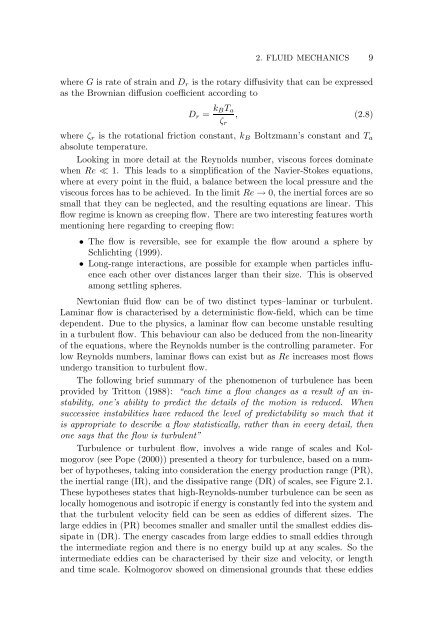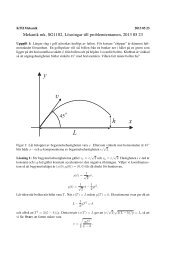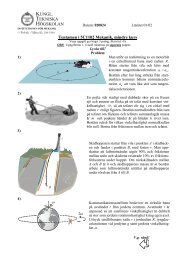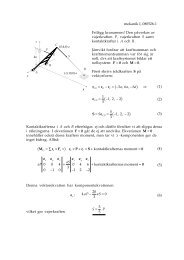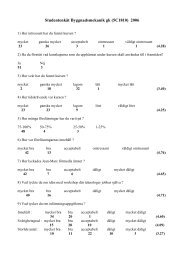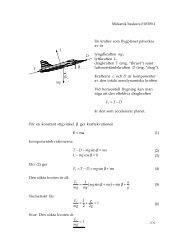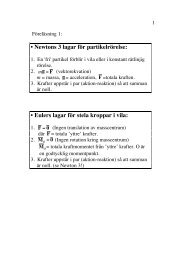Fluid mechanics of fibre suspensions related to papermaking - DiVA
Fluid mechanics of fibre suspensions related to papermaking - DiVA
Fluid mechanics of fibre suspensions related to papermaking - DiVA
You also want an ePaper? Increase the reach of your titles
YUMPU automatically turns print PDFs into web optimized ePapers that Google loves.
2. FLUID MECHANICS 9<br />
where G is rate <strong>of</strong> strain and Dr is the rotary diffusivity that can be expressed<br />
as the Brownian diffusion coefficient according <strong>to</strong><br />
Dr = kBTa<br />
, (2.8)<br />
ζr<br />
where ζr is the rotational friction constant, kB Boltzmann’s constant and Ta<br />
absolute temperature.<br />
Looking in more detail at the Reynolds number, viscous forces dominate<br />
when Re ≪ 1. This leads <strong>to</strong> a simplification <strong>of</strong> the Navier-S<strong>to</strong>kes equations,<br />
where at every point in the fluid, a balance between the local pressure and the<br />
viscous forces has <strong>to</strong> be achieved. In the limit Re → 0, the inertial forces are so<br />
small that they can be neglected, and the resulting equations are linear. This<br />
flow regime is known as creeping flow. There are two interesting features worth<br />
mentioning here regarding <strong>to</strong> creeping flow:<br />
• The flow is reversible, see for example the flow around a sphere by<br />
Schlichting (1999).<br />
• Long-range interactions, are possible for example when particles influence<br />
each other over distances larger than their size. This is observed<br />
among settling spheres.<br />
New<strong>to</strong>nian fluid flow can be <strong>of</strong> two distinct types–laminar or turbulent.<br />
Laminar flow is characterised by a deterministic flow-field, which can be time<br />
dependent. Due <strong>to</strong> the physics, a laminar flow can become unstable resulting<br />
in a turbulent flow. This behaviour can also be deduced from the non-linearity<br />
<strong>of</strong> the equations, where the Reynolds number is the controlling parameter. For<br />
low Reynolds numbers, laminar flows can exist but as Re increases most flows<br />
undergo transition <strong>to</strong> turbulent flow.<br />
The following brief summary <strong>of</strong> the phenomenon <strong>of</strong> turbulence has been<br />
provided by Trit<strong>to</strong>n (1988): “each time a flow changes as a result <strong>of</strong> an instability,<br />
one’s ability <strong>to</strong> predict the details <strong>of</strong> the motion is reduced. When<br />
successive instabilities have reduced the level <strong>of</strong> predictability so much that it<br />
is appropriate <strong>to</strong> describe a flow statistically, rather than in every detail, then<br />
one says that the flow is turbulent”<br />
Turbulence or turbulent flow, involves a wide range <strong>of</strong> scales and Kolmogorov<br />
(see Pope (2000)) presented a theory for turbulence, based on a number<br />
<strong>of</strong> hypotheses, taking in<strong>to</strong> consideration the energy production range (PR),<br />
the inertial range (IR), and the dissipative range (DR) <strong>of</strong> scales, see Figure 2.1.<br />
These hypotheses states that high-Reynolds-number turbulence can be seen as<br />
locally homogenous and isotropic if energy is constantly fed in<strong>to</strong> the system and<br />
that the turbulent velocity field can be seen as eddies <strong>of</strong> different sizes. The<br />
large eddies in (PR) becomes smaller and smaller until the smallest eddies dissipate<br />
in (DR). The energy cascades from large eddies <strong>to</strong> small eddies through<br />
the intermediate region and there is no energy build up at any scales. So the<br />
intermediate eddies can be characterised by their size and velocity, or length<br />
and time scale. Kolmogorov showed on dimensional grounds that these eddies


